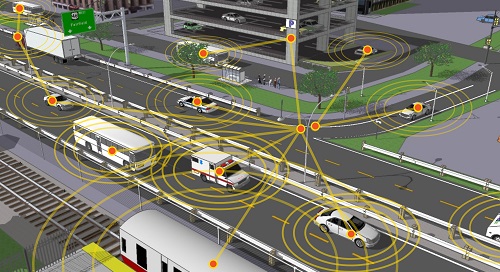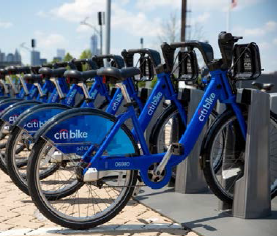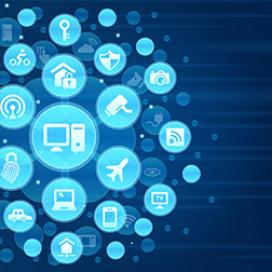Laying the Groundwork for Smart, Connected Cities
In the city of the future, open parking spaces will tell drivers their whereabouts, conserving fuel and reducing emissions, and garbage cans will tell trash collectors when they’re full, saving unnecessary trips from sanitation trucks.
Streetlights will conserve energy by turning off when no one’s around, and a range of on-the-spot mobility options will be at people’s fingertips—be it bus, car share, bike share, or taxi—ready for purchase and recommended for users based on current availability and traffic conditions.
Tens of thousands of everyday objects—including cell phones, light poles, cars, and even pavement markers—will serve as data receivers, transmitters, and processors. This intelligent infrastructure—or “Internet of Things”—will feed information into a network of interconnected systems that work in concert to improve efficiency and coordinate city services.
This is not the stuff of science fiction.
These are elements of a “smart city” or “connected city,” and technologies like this already exist.
“I don’t think there’s currently a working, comprehensive model of a smart/connected city that pulls together everything that’s possible,” said Volpe project manager Matt Burt. “But most of the technological elements are real and available, and new deployments are occurring every day.”

In a smart/connected city, all critical city systems are capable of communicating with each other to allow coordination and improve efficiency.
The Path Forward
Given that these technologies exist, the next challenge lies in synching them up in a way that transforms the future of our cities—and the U.S. Department of Transportation is studying the path forward.
U.S. DOT’s Intelligent Transportation Systems Joint Program Office (ITS JPO) has released a white paper that presents a vision of the smart/connected city and lays the groundwork for future research.
Written by Volpe under sponsorship of the ITS JPO Connected Cities Program, this white paper lays out the rationale for smart/connected cities, offers an assessment and synthesis of the current state, and identifies key questions that should be considered in future research.
Dynamics of Smart/Connected Cities
In a smart/connected city, all critical city systems—transportation, utilities, employment, health care, public safety, education, and others—are capable of communicating with each other to allow coordination and improve efficiency.
“The result: more harmony, more efficiency, less waste,” said Volpe operations research analyst Matt Cuddy, one of the paper’s co-authors.
 Smart/connected cities have three major dynamics that set them apart from traditional cities: intelligent infrastructure, information and communications technologies that tie together the network of integrated systems, and a smart grid to power it all.
Smart/connected cities have three major dynamics that set them apart from traditional cities: intelligent infrastructure, information and communications technologies that tie together the network of integrated systems, and a smart grid to power it all.
Transportation will also play a key role in these cities.
“For the cities of the future to work, they need transportation that works,” said Cuddy. “Our thinking is that the only transportation that works in a future of urbanization and energy concerns is connected transportation.”
Connected vehicles offer cities the opportunity to provide more responsive, efficient mobility solutions in real time across all transportation modes, including transit, bicycling, electric vehicles, and shared mobility services. Connected vehicles could also interact with a city’s smart grid, reducing energy consumption and improving efficiency.
Next Steps
Challenges that have to be considered in planning for smart/connected cities include ensuring data accuracy and security, user privacy, and system resilience. However, achieving cooperation across diverse agency types—including both government and private sector organizations—may present the greatest challenge of all.
“Institutional cooperation is the major challenge we face in making the full vision of a smart/connected city real,” said Cuddy. “This white paper is hopefully the beginning of a really thoughtful dialog with the community of experts: academics, researchers, computer scientists, transportation modelers, businesses, and city governments.”
Volpe’s work in the area of smart/connected cities continues to move forward along several fronts. These include supporting the ITS JPO Connected Cities Program and investigating concepts such as mobility on demand for the Federal Transit Administration.
For more information, read the white paper The Smart/Connected City and Its Implications for Connected Transportation.
For more information on the ITS JPO Connected Cities Program, contact Marcia Pincus, Connected Cities Program manager, at marica.pincus@dot.gov.

